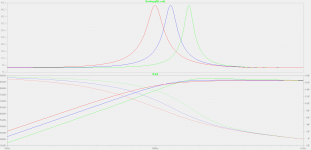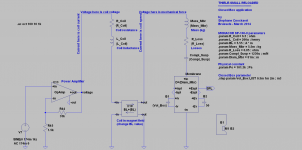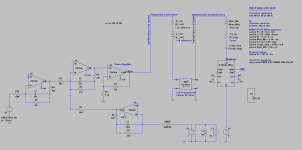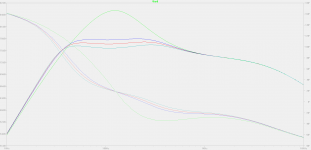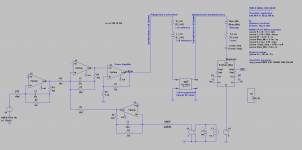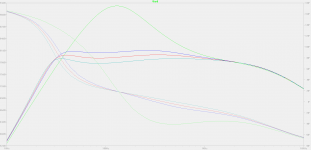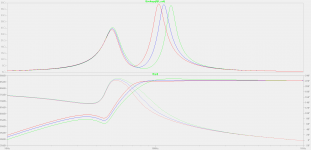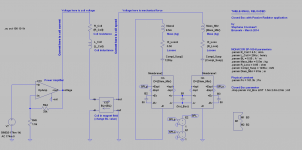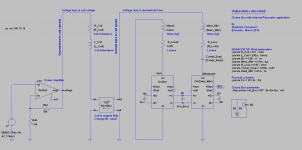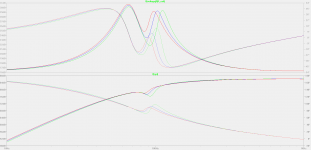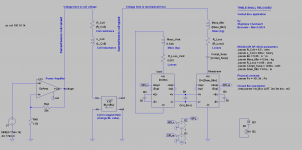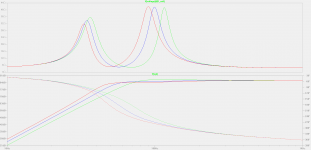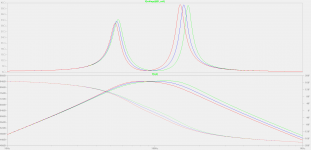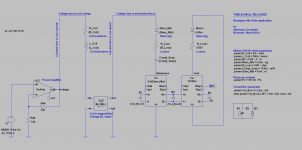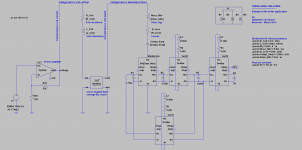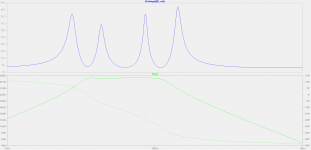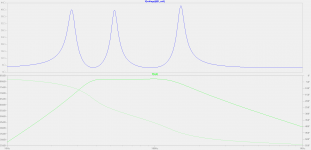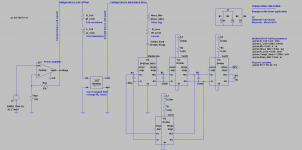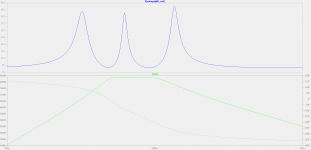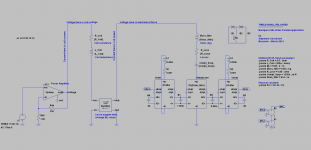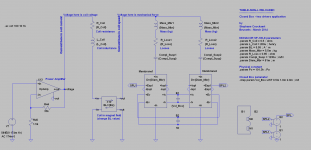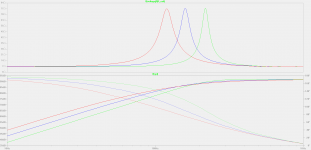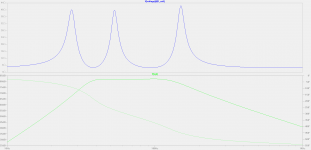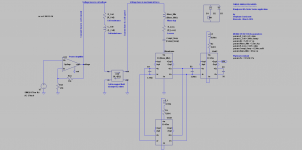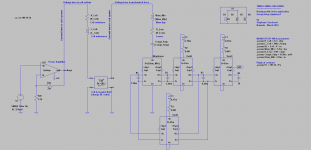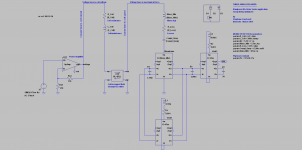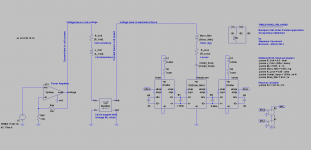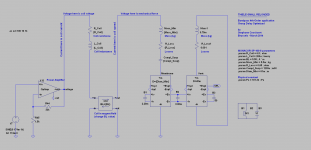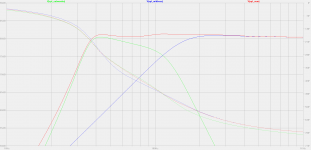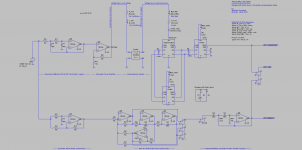After nearly 4 years, here is a new .zip you can download.
No use of Laplace functions anymore for deriving acceleration from speed.
No use of Laplace functions anymore in the opamp model.
New moving surface subcircuit.
This now opus covering multi-chamber designs could act as inspiration source for Jean-Marc Plantefève, for helping him developing new and more ambitious "Spiceotron" loudspeaker systems.
Box volumes are in cubic meter.
They are represented by capacitors in Farads.
B1=10m means 10 liters
B2=50 means 50 cubic meter (aka your listening room volume)
Membrane mass are in kilo.
They are represented by inductances in Henrys.
Air vent mass are in kilo.
They are represented by inductances in Henrys.
L1=5m means 5 gram.
The first subcircuit is the well known (ideal) gyrator modelling both the mechanical force and the motional voltage, something dating back from Prof. W. Marshall Leach Jr. (AES 1991).
The associated parameter is the BL force factor expressed in Newton / Ampere.
BL=5.55 means 5.55 Newton of mechanical force, for 1 Ampere of current.
The second subcircuit is new. This is my creation.
This is the membrane surface or vent surface representation.
The associated parameter is the diameter expressed in meter.
D=30m means a diameter of 30 millimeter (typically, a vent)
D=81m means a diameter of 81 millimeter (typically, a small speaker driver)
Such subcircuit has two connecting ports, for describing the two volumes (boxes in liters represented by capacitors) connecting on each side.
The +Ev -Ev port connects to the exterior world. Typically the volume connecting to it is your listening room, say 50 cubic meter.
The +Iv -Iv port connects to the internal volume. Typically the volume connecting to it is the bow volume, say between 1 liter and 10 liter.
Note how a membrane and a vent are modeled by that same subcircuit.
It doesn't matter, if the moving interface is made of rigid material (a speaker membrane), or if the moving interface is made of some air section (a vent).
What only matters at this stage, is to let LTspice compute the equivalent compliance that's emerging from a moving surface (speaker membrane or air section) connecting to a given box volume.
The exterior world compliance and the internal box volume compliance appear as impedance's in series. Indeed, a speaker membrane or a vent get free to move, only if the box volume (considered as internal) and if the listening room volume (considered as external) are close to infinite, both of them.
In a nutshell, the moving surface subcircuit role is to "sense" the two environments (+Iv -Iv internal volume, +Ev -Ev external volume), for applying the adequate scaling factor for controlling the amount of "current" vertically flowing from the "+in" port to the "-in" port. Such "current" has a high significance : this is the membrane speed when considering a speaker membrane. This is the vent air speed when considering a vent. From there, we can derive the SPL.
By making use of LTspice, such "sense" process is bidirectional. Energy can flow to any box volume, and energy can come from any box volume. This is due to the use of transformers inside the moving surface subcircuit. The current flowing (vertically) from the "+in" port to the "-in" port will see a huge impedance (two times 1k Henry in series) if nothing gets connected to the Ev and Iv ports.
In our case, "nothing" of "left open" is thus equivalent to "blocked".
In our case, "free" is represented by a 50 cubic meter volume (your typical listening room).
The transformer ratio is equal to 101.3k*3.14*3.14*({D}/2)**4.
D is the diameter. This is the formula giving the equivalent compliance of a surface moving inwards and onwards, on a box filled with air.
In a nutshell, this is how the moving surface subcircuit "senses" the two environments (inside and outside the box), and computes the equivalent compliance seen by the "current" representing the local speed.
Sound pressure is the time derivative of the speed. Consequently, inside the moving surface subcircuit, I added two ports that can be used for outputting the local SPL.
Those two SPL ports are quite redundant, as I have not played with their polarity. They are there, for the symmetry purpose, for making clear what side of the membrane we are using for computing the SPL we are listening to.
For computing the time derivative of the speed, we use controlled current sources connecting to a 1 Henry coil. The coil voltage becomes thus the time derivative of the speed. We use D, the diameter parameter, for scaling the SPL. The scaling formula is D*D*5.0e3, giving final results well in line with the speaker manufacturer's "dB/watt 8 ohm 1 meter" standard.
Make sure you connect all needed grounds, otherwise LTspice will complain by saying "Analysis Failed: Matrix is singular".
Enjoy.
No use of Laplace functions anymore for deriving acceleration from speed.
No use of Laplace functions anymore in the opamp model.
New moving surface subcircuit.
This now opus covering multi-chamber designs could act as inspiration source for Jean-Marc Plantefève, for helping him developing new and more ambitious "Spiceotron" loudspeaker systems.
Box volumes are in cubic meter.
They are represented by capacitors in Farads.
B1=10m means 10 liters
B2=50 means 50 cubic meter (aka your listening room volume)
Membrane mass are in kilo.
They are represented by inductances in Henrys.
Air vent mass are in kilo.
They are represented by inductances in Henrys.
L1=5m means 5 gram.
The first subcircuit is the well known (ideal) gyrator modelling both the mechanical force and the motional voltage, something dating back from Prof. W. Marshall Leach Jr. (AES 1991).
The associated parameter is the BL force factor expressed in Newton / Ampere.
BL=5.55 means 5.55 Newton of mechanical force, for 1 Ampere of current.
The second subcircuit is new. This is my creation.
This is the membrane surface or vent surface representation.
The associated parameter is the diameter expressed in meter.
D=30m means a diameter of 30 millimeter (typically, a vent)
D=81m means a diameter of 81 millimeter (typically, a small speaker driver)
Such subcircuit has two connecting ports, for describing the two volumes (boxes in liters represented by capacitors) connecting on each side.
The +Ev -Ev port connects to the exterior world. Typically the volume connecting to it is your listening room, say 50 cubic meter.
The +Iv -Iv port connects to the internal volume. Typically the volume connecting to it is the bow volume, say between 1 liter and 10 liter.
Note how a membrane and a vent are modeled by that same subcircuit.
It doesn't matter, if the moving interface is made of rigid material (a speaker membrane), or if the moving interface is made of some air section (a vent).
What only matters at this stage, is to let LTspice compute the equivalent compliance that's emerging from a moving surface (speaker membrane or air section) connecting to a given box volume.
The exterior world compliance and the internal box volume compliance appear as impedance's in series. Indeed, a speaker membrane or a vent get free to move, only if the box volume (considered as internal) and if the listening room volume (considered as external) are close to infinite, both of them.
In a nutshell, the moving surface subcircuit role is to "sense" the two environments (+Iv -Iv internal volume, +Ev -Ev external volume), for applying the adequate scaling factor for controlling the amount of "current" vertically flowing from the "+in" port to the "-in" port. Such "current" has a high significance : this is the membrane speed when considering a speaker membrane. This is the vent air speed when considering a vent. From there, we can derive the SPL.
By making use of LTspice, such "sense" process is bidirectional. Energy can flow to any box volume, and energy can come from any box volume. This is due to the use of transformers inside the moving surface subcircuit. The current flowing (vertically) from the "+in" port to the "-in" port will see a huge impedance (two times 1k Henry in series) if nothing gets connected to the Ev and Iv ports.
In our case, "nothing" of "left open" is thus equivalent to "blocked".
In our case, "free" is represented by a 50 cubic meter volume (your typical listening room).
The transformer ratio is equal to 101.3k*3.14*3.14*({D}/2)**4.
D is the diameter. This is the formula giving the equivalent compliance of a surface moving inwards and onwards, on a box filled with air.
In a nutshell, this is how the moving surface subcircuit "senses" the two environments (inside and outside the box), and computes the equivalent compliance seen by the "current" representing the local speed.
Sound pressure is the time derivative of the speed. Consequently, inside the moving surface subcircuit, I added two ports that can be used for outputting the local SPL.
Those two SPL ports are quite redundant, as I have not played with their polarity. They are there, for the symmetry purpose, for making clear what side of the membrane we are using for computing the SPL we are listening to.
For computing the time derivative of the speed, we use controlled current sources connecting to a 1 Henry coil. The coil voltage becomes thus the time derivative of the speed. We use D, the diameter parameter, for scaling the SPL. The scaling formula is D*D*5.0e3, giving final results well in line with the speaker manufacturer's "dB/watt 8 ohm 1 meter" standard.
Make sure you connect all needed grounds, otherwise LTspice will complain by saying "Analysis Failed: Matrix is singular".
Enjoy.
Attachments
-
LTspice Speaker Simulation (mars 2014) part 1 of 2.zip637.7 KB · Views: 51
-
LTspice Speaker Simulation (mars 2014) part 2 of 2.zip467.9 KB · Views: 56
-
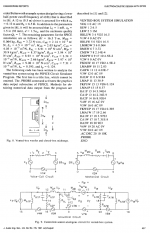 0. Prof. W. Marshall Leach Jr. (AES 1991).png124.9 KB · Views: 262
0. Prof. W. Marshall Leach Jr. (AES 1991).png124.9 KB · Views: 262 -
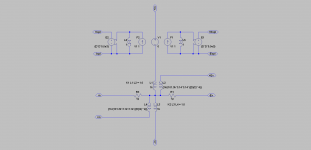 0. moving surface (subcircuit).png21.9 KB · Views: 252
0. moving surface (subcircuit).png21.9 KB · Views: 252 -
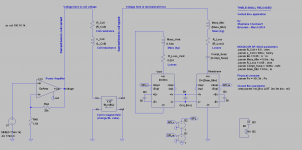 4. Vented Box.png79.8 KB · Views: 243
4. Vented Box.png79.8 KB · Views: 243 -
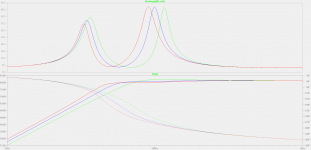 4. Vented Box (results).png26.6 KB · Views: 249
4. Vented Box (results).png26.6 KB · Views: 249
7. Bandpass 6th-Order Series
You need the above .zip for the subcircuits.
You need the above .zip for the subcircuits.
Attachments
8. Bandpass 6th-Order Parallel
You need the above .zip for the subcircuits.
You need the above .zip for the subcircuits.
Attachments
7. Bandpass 6th-Order Series
The .png file in post #11 was incorrect
You need the above .zip for the subcircuits.
Pretty interesting result. A single vent delivers about three octaves of deep bass. Less complicated than the 3-chamber 8th-Order Bandpass.
The .png file in post #11 was incorrect
You need the above .zip for the subcircuits.
Pretty interesting result. A single vent delivers about three octaves of deep bass. Less complicated than the 3-chamber 8th-Order Bandpass.
Attachments
Last edited:
Let's see what's happening with bandpass designs, when optimizing the group delay.
Such group delay optimization will enable delay compensated subtractive crossovers.
Let's compare the four bandpass designs :
- 4th-Order
- 6th-Order Parallel
- 6th-Order Series
- 8th-Order.
Such group delay optimization will enable delay compensated subtractive crossovers.
Let's compare the four bandpass designs :
- 4th-Order
- 6th-Order Parallel
- 6th-Order Series
- 8th-Order.
Attachments
-
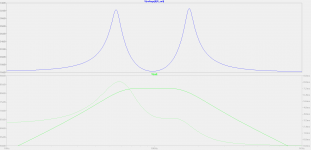 Bandpass 4th-Order (group delay optimized) (results).png19.2 KB · Views: 39
Bandpass 4th-Order (group delay optimized) (results).png19.2 KB · Views: 39 -
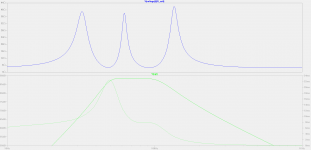 Bandpass 6th-Order Parallel (group delay optimized) (results).png19.3 KB · Views: 35
Bandpass 6th-Order Parallel (group delay optimized) (results).png19.3 KB · Views: 35 -
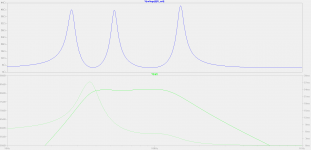 Bandpass 6th-Order Series (group delay optimized) (results).png18.8 KB · Views: 39
Bandpass 6th-Order Series (group delay optimized) (results).png18.8 KB · Views: 39 -
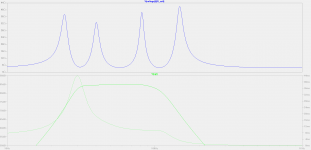 Bandpass 8th-Order (group delay optimized) (results).png18.6 KB · Views: 42
Bandpass 8th-Order (group delay optimized) (results).png18.6 KB · Views: 42
Last edited:
Corresponding bandpass schematics here.
Attachments
corresponding LTspiceIV .asc files here
Attachments
Bandpass 6th-Order Series & Closed Box (analog design sheet)
Attachments
Bandpass 6th-Order Series & Closed Box (digital design sheet)
Attachments
-
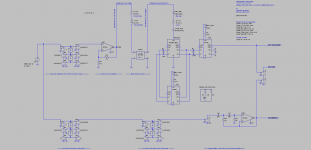 Bandpass 6th-Order Series & Closed Box (digital design sheet).png54.9 KB · Views: 47
Bandpass 6th-Order Series & Closed Box (digital design sheet).png54.9 KB · Views: 47 -
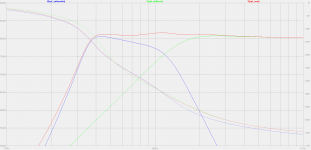 Bandpass 6th-Order Series & Closed Box (digital design sheet) (results).png32.3 KB · Views: 51
Bandpass 6th-Order Series & Closed Box (digital design sheet) (results).png32.3 KB · Views: 51 -
Bandpass 6th-Order Series & Closed Box (digital design sheet).asc12.6 KB · Views: 32
-
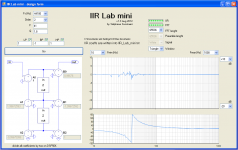 Bandpass 6th-Order Series & Closed Box (41 Hz Q 1.8 4th-Order Phase Synchronizer).png55.9 KB · Views: 54
Bandpass 6th-Order Series & Closed Box (41 Hz Q 1.8 4th-Order Phase Synchronizer).png55.9 KB · Views: 54 -
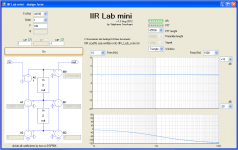 Bandpass 6th-Order Series & Closed Box (106 Hz 2nd-Order Phase Synchronizer).png53.4 KB · Views: 46
Bandpass 6th-Order Series & Closed Box (106 Hz 2nd-Order Phase Synchronizer).png53.4 KB · Views: 46 -
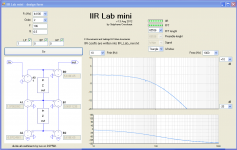 Bandpass 6th-Order Series & Closed Box (106 Hz Q 0.5 2nd-Order Lowpass).png52.6 KB · Views: 44
Bandpass 6th-Order Series & Closed Box (106 Hz Q 0.5 2nd-Order Lowpass).png52.6 KB · Views: 44 -
Delay.zip1.6 KB · Views: 27
- Status
- This old topic is closed. If you want to reopen this topic, contact a moderator using the "Report Post" button.
- Home
- Loudspeakers
- Multi-Way
- Monacor SP-100-8 LTspiceIV simulations
